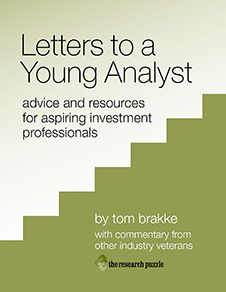
- Monday, August 30th, 2010
- a street named desire
-
In A Streetcar Named Desire, Tennessee Williams’ classic play, Blanche DuBois has been forced to leave her once-stately Mississippi home, now lost to foreclosure. She makes her way to her sister’s modest dwelling in New Orleans, the last stretch by way of a streetcar with that fateful name, still gripped by her delusions of grandeur and not prepared at all for what is to come.
As the story unfolds, the layers of desire and events of the past are laid bare, and the façades come tumbling down. The arc of the tragedy encompasses generations, with years of unwinding having been played out in slow motion before the few months of cathartic action in the play.
It is a dramatic use of poetic license to say that it seems like the business of investments is on a similar journey, but the similarities are there. Decades of good times fostered beliefs that in a harsh light don’t seem as beautiful as they once did: efficient markets, modern portfolio theory, buy-and-hold investing, faith in the Fed and the Great Moderation, deregulation, the wizards of Wall Street, and on and on.
Like Blanche clinging to the plantation house and what it represented, investors, investment professionals, and investment firms are hanging onto memories of the way things were. An edifice was created, but can — or should — it be sustained?
To be sure, employment is down in certain parts of the business, but the slice of our economy dedicated to managing, massaging, and manipulating other people’s money remains substantial. And the infrastructure to make it happen, with some notable exceptions, remains in place. Is it possible that we’ll see the business (with or without the markets doing so in tandem) correct enough that we’ll see big drops in the number of funds and ETFs, of asset managers, of those sitting for the CFA exams, of industry employment, and of financial advisors, who after a punk decade still seem as ubiquitous as California real estate agents in 2006?
Will changes in the flow of information be a powerful force of disintermediation, ripping up the old business models of the markets?
And, most importantly, what will happen to the attitudes that shaped a generation of money decisions? Blanche lost Belle Rive, her beloved home place, but that was just a prelude to the climactic loss of beliefs that had defined her. Similarly, we need to get back to square one, a journey started in the wake of the financial crisis, but not yet completed.
When we get there, I hope that:
We have rid ourselves of the unrealistic assumptions about markets which have formed the foundation of much investment advice. They fostered unwarranted expectations, helped shape an avoidance of thrift by individuals, and contributed to dreadful decisions by fiduciaries responsible for the oversight of pension plans and other pools of money.
We have found along the way a skepticism that can cut through the layers of obfuscation that have characterized our financial give-and-take. Buyers of investment products should know the fees and exposures that come with a purchase, and be presented with a faithful picture of the potential for loss as well as gain. It’s amazing the degree to which the business has been dedicated to obscuring those things.
We have recognized the strangulation of investment creativity that has resulted from an undue focus on short-term results and the reliance on relative performance comparisons that are counterproductive.
The recent struggles of the industry have been modest in the aggregate in comparison to the times that preceded them, but a lurking shadow remains on its doorstep. If it does not rework and reform itself, there will be a date with destiny down the road, like Blanche and her ways coming face to face with Stanley Kowalski and his.
